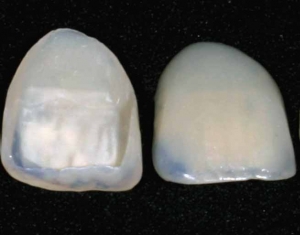What are students learning about at Star of Texas Dental Assisting School?
We are the best Austin dental assisting school because we are dedicated to our students’ education and making sure they are prepared for a career in the dental field.
Let’s talk about one subject our students explore, veneers!
 When people speak of “bonding” their teeth to make them look better, they are usually referring to either porcelain or resin veneers. Veneers cover only the outside portion of the tooth, the part that shows when you smile or talk. In fact, all tooth-colored dental restorative materials are bonded, whether the restoration is in a front tooth or a back tooth. Strictly speaking, in dentistry, bonding refers only to adhesive joining of two dissimilar materials. Silver fillings can be bonded, as can crowns (caps).
When people speak of “bonding” their teeth to make them look better, they are usually referring to either porcelain or resin veneers. Veneers cover only the outside portion of the tooth, the part that shows when you smile or talk. In fact, all tooth-colored dental restorative materials are bonded, whether the restoration is in a front tooth or a back tooth. Strictly speaking, in dentistry, bonding refers only to adhesive joining of two dissimilar materials. Silver fillings can be bonded, as can crowns (caps).
Porcelain and resin veneers are placed in order to correct slight or severe defects in tooth alignment, shape, or color. They are also placed when teeth have been moderately restored and the teeth have been weakened. This is done when there is still enough enamel left for the bonding to be successful. If the teeth are in very poor alignment or there is insufficient enamel remaining, bonding to improve the appearance is not possible. At that point orthodontics or full-coverage crowns must be considered. The most common use for bonding veneers, either porcelain or resin, is to improve the cosmetic appearance of the patient.
Without question, porcelain veneers look the best and last the longest. They are indicated when the teeth are in fair to good alignment or when a more pleasing tooth color is desired. They are not usually placed in a patient under 16 years of age. The procedure usually requires some slight to moderate tooth preparation (drilling). Local anesthesia is usually necessary. The procedure requires two separate appointments, approximately 10 days apart to complete. This is because the veneers are constructed in an offsite laboratory. Once bonded into place, the porcelain veneers become very strong. The success rate is high, and they can last up to 12 or more years. Anything that will break your natural teeth can break the porcelain veneers, for example, hard candy or frozen candy bars. Veneers are highly stain resistant. They are a good treatment choice when all the front teeth are being restored. They are more expensive than resin veneers, but they last longer and look better than resin. Porcelain biting surfaces can cause more rapid wear of opposing natural teeth.
Resin veneers are also available. They are placed by the dentist in one office visit. Resin veneers are used in similar situations to porcelain veneers. However, they last only half as long before requiring repair or replacement. They are advised for patients who are still growing. They look very good but are not as good as porcelain. While repairs to the resin veneers are not too difficult, they have a tendency to chip more than porcelain veneers.
Basically, porcelain looks better, lasts longer, is stronger, more expensive, and requires two dental appointments to complete. Resin veneers are less expensive, easier to repair, and better for children, or if there are financial considerations.
It is very important to come in for regular recare appointments for cleaning and examination if either type of veneer is placed. This way, we will be better able to quickly correct any problems that develop. A 3- to 4-month interval between appointments is customary.
Call Star of Texas Dental Assisting School if you have any questions or would like to enroll for our 12-week program! (512) 487-1547

